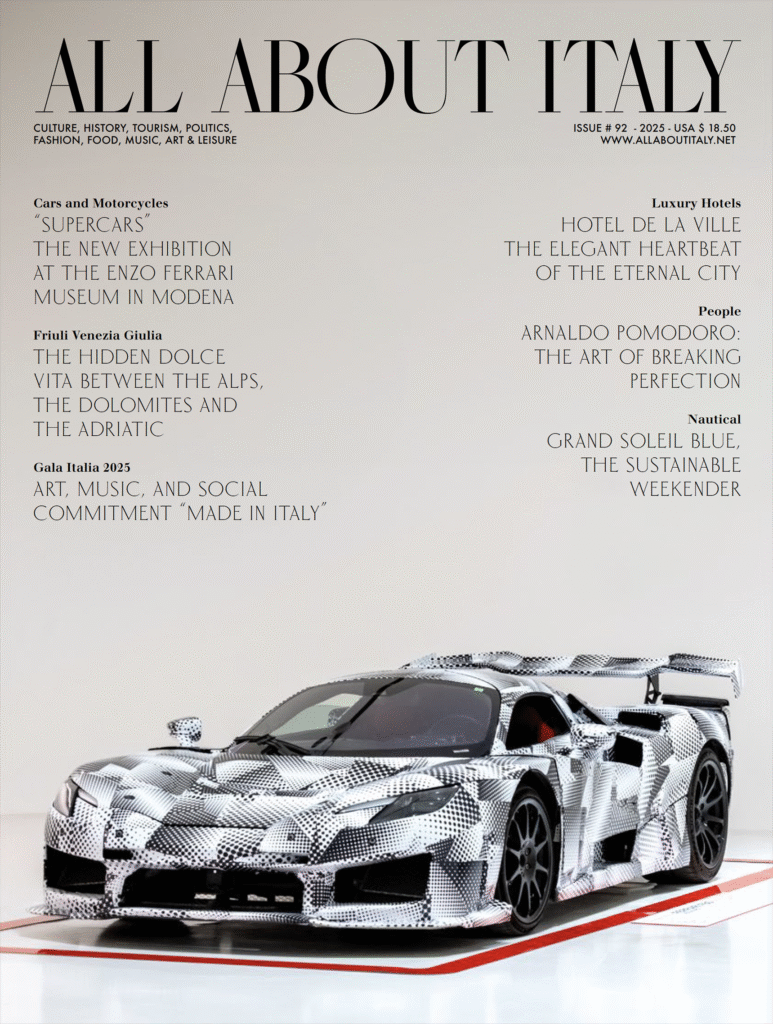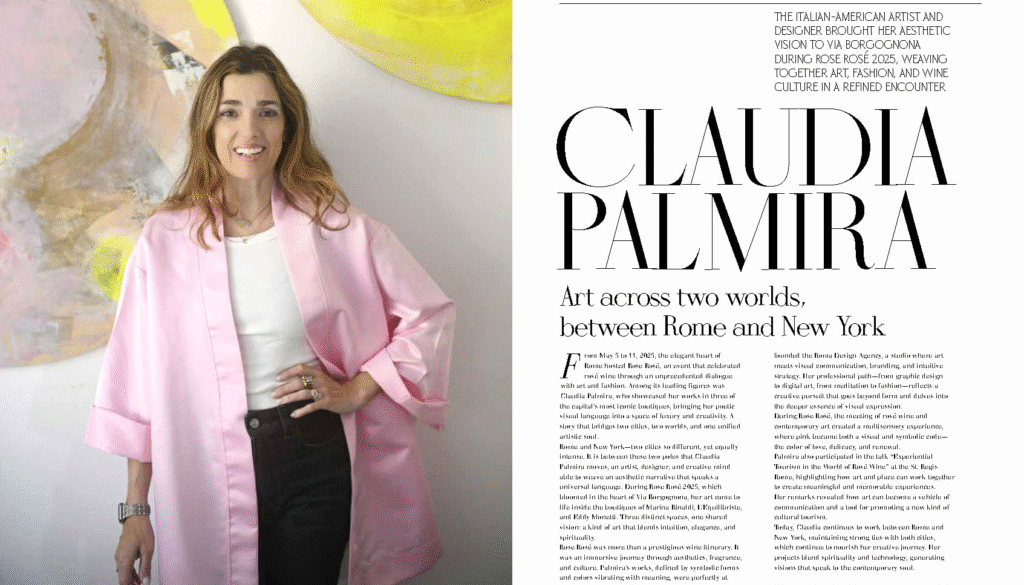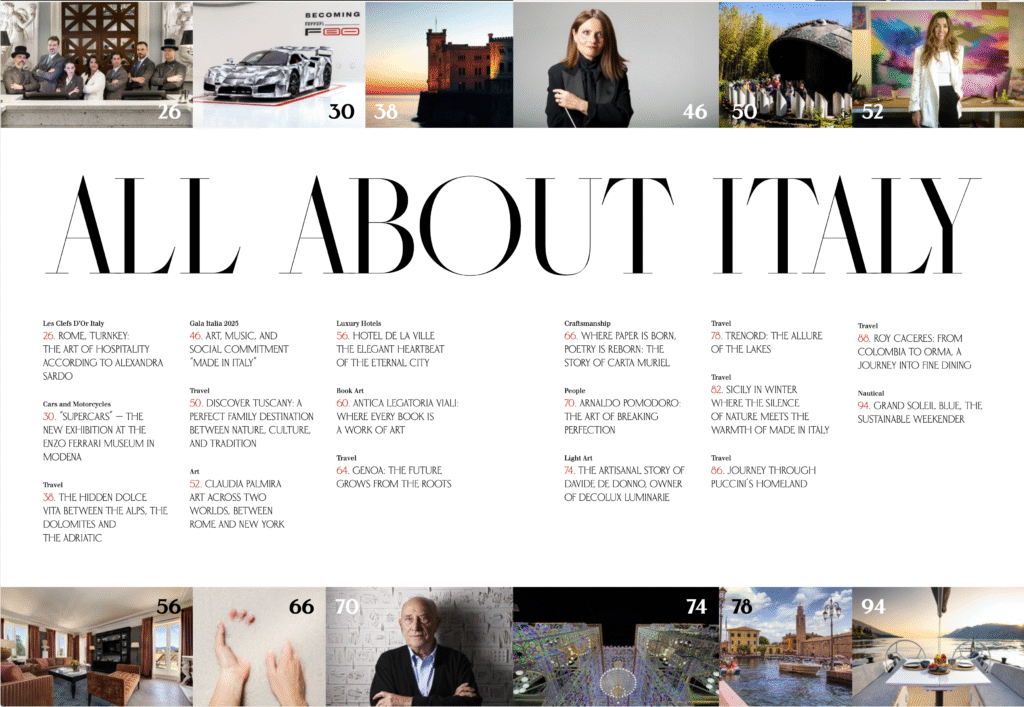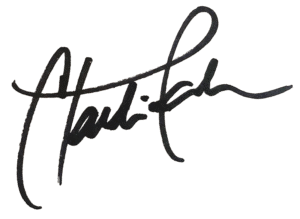All About Italy magazine

ALL ABOUT ITALY | Issue 92 | October 2025
CLAUDIA PALMIRA
The Italian-American artist and designer brought her aesthetic vision to Via Borgognona during Rose Rosé 2025, weaving together art, fashion, and wine culture in a refined encounter.
Art across two worlds, between Rome and New York.
From May 5 to 11, 2025, the elegant heart of Rome hosted Rose Rosé, an event that celebrated rosé wine through an unprecedented dialogue with art and fashion. Among its leading figures was Claudia Palmira, who showcased her works in three of the capital’s most iconic boutiques, bringing her poetic visual language into a space of luxury and creativity. A story that bridges two cities, two worlds, and one unified artistic soul.
Rome and New York—two cities so different, yet equally intense. It is between these two poles that Claudia Palmira moves, an artist, designer, and creative mind able to weave an aesthetic narrative that speaks a universal language. During Rose Rosé 2025, which bloomed in the heart of Via Borgognona, her art came to life inside the boutiques of Marina Rinaldi, L’Equilibriste, and Eddy Monetti. Three distinct spaces, one shared vision: a kind of art that blends intuition, elegance, and spirituality.
Rose Rosé was more than a prestigious wine itinerary. It was an immersive journey through aesthetics, fragrance, and culture. Palmira’s works, defined by symbolic forms and colors vibrating with meaning, were perfectly at home in this context. Each piece served as a visual portal, an invitation to inner reflection and connection with the unseen.
Since moving to Rome in 2006, Claudia Palmira has founded the Roma Design Agency, a studio where art meets visual communication, branding, and intuitive strategy. Her professional path—from graphic design to digital art, from meditation to fashion—reflects a creative pursuit that goes beyond form and delves into the deeper essence of visual expression.
During Rose Rosé, the meeting of rosé wine and contemporary art created a multisensory experience, where pink became both a visual and symbolic code—the color of love, delicacy, and renewal. Palmira also participated in the talk “Experiential Tourism in the World of Rosé Wine” at the St. Regis Rome, highlighting how art and place can work together to create meaningful and memorable experiences. Her remarks revealed how art can become a vehicle of communication and a tool for promoting a new kind of cultural tourism.
Today, Claudia continues to work between Rome and New York, maintaining strong ties with both cities, which continue to nourish her creative journey. Her projects blend spirituality and technology, generating visions that speak to the contemporary soul.
Interview
What does the color pink represent to you, especially given how central it was to this event? Does it have symbolic meaning in your work?
In short, pink represents joy for me. A certain kind of bright pink always gives me a sense of modernity and freshness. When I see it appear in artworks—even in medieval gilded pieces or other settings—it always has a slightly irreverent touch. This color vibrates powerfully in all its shades, from the softest and most innocent to the deepest magenta, full of passion, calm spirituality, gentle tenderness, and bold innovation. Magenta is the color of my brand’s logo, and pink recurs throughout my work. It is also the color I chose for the packaging of my silk scarf line, Clù.
How do you maintain creative balance between Rome and New York, two cities so powerful yet so different in energy?
You’re right—Rome and New York each have their own intensely unique identity. New York is home for me. Its sharp, ambitious energy shaped me, with its entrepreneurial spirit and belief that yes, your dreams can come true. I bring that approach with me to the Eternal City, sumptuous, romantic, and profound, where I reconnect with an incredibly rich artistic tradition that invites me to slow down and take things in. Blending the dynamic of those two energies has been central to my journey in Italy and has deeply influenced my work. Balance is never static—it’s a continuous process of adjustment and evolution.
How has your experience as a designer influenced your approach to visual art?
Graphic design has always been an extension of my artistic practice, ever since I discovered digital design as a teenager. Design has this wonderful ability to create visual order and hierarchy, and by nature, it always has a purpose. In design, I found a container for my expression—one that also served others. Painting, on the other hand, requires more emotional involvement. It’s about exploring the soul through artistic gesture, with a much more ethereal function.
Art and design coexist in conversation within me, something you can also see in my silk scarf line, which begins as paintings. Silk gives life to the artwork, transforming it into something wearable, a piece of fashion—and for me, a fragment of time. My design sensibility also comes through in my Iconics/Poetics series. I start with a painting or drawing, then assemble the elements into a collage, import it into a digital space, and continue to elaborate. The final result is printed on acrylic glass, with a defined and distinctly design-driven aesthetic.
At the St. Regis talk, you discussed experiential tourism linked to wine and art. How do you envision the future of these hybrid events?
What made this event so beautiful was the overlap of three distinct creative worlds: art, fashion, and wine. In each of these spaces, there are “artists” who develop ideas and express them through very different mediums. I’m especially drawn to events that foster collaborations and exchanges between disciplines, because they create connections between communities.
For example, during Rose Rosé, one of my works was displayed in Eddy Monetti’s boutique, a space famous for more than a hundred years for its refined menswear. Before the event, I would never have imagined that my work could resonate so well in that space or with its clientele. That’s the surprising magic that happens when new combinations and conversations come to life. I envision events, gatherings, and conferences that unite ideas and communities, inspiring people to engage and live creatively. The unexpected takes shape, and I believe more and more that this is something people long for—and need.
There are countless combinations between visual arts, design concepts, gastronomy, and wine that could give rise to meaningful and joyful experiences.
What are your upcoming projects, and what themes are you drawn to explore in the coming months?
There are several projects I’m working on this year, in addition to autumn exhibitions focused on completed works. One new theme I’m exploring draws from the writings of a 20th-century author from the Science of Mind movement. Often, when I paint words or phrases, the letters lose their original structure and transform into abstract marks. This process continues to fascinate me, especially after studying calligraphic gesture in Japan.
A book of mine, titled Micro Daily Practice, will be published this year. It was born out of my creative mentoring programs, and I’m excited to share it. Lastly, I’m launching a line of silk kimonos for my brand Clù, featuring my artworks printed on silk. They will be available at the Met Opera Shop and online. This has been a long-term dream, and I’m thrilled to see these pieces take form in a fashion design format that brings my art into the world.
Claudia Palmira embodies the synthesis of diverse worlds: art and communication, spirituality and practicality, aesthetics and purpose. Her presence at Rose Rosé 2025 confirmed how art still has the power to stir, to question, and to connect. A visual journey that moves beyond form to touch the essence of things.
The Italian version of this article appears in the sister publication In Progress.




